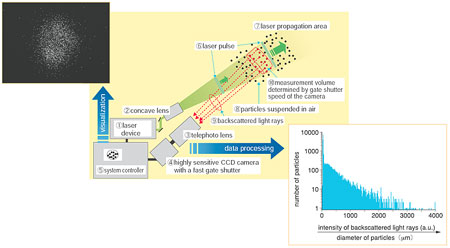To resolve environmental issues such as the influence of air pollution and the greenhouse effect, recent studies addressing the behavior of aerosols and Suspended Particulate Matter (SPM) have been extensively conducted. However, conventional measurement methods are unable to measure SPM accurately because they cannot determine the density and diameter of the SPM on a real-time basis. A novel particle counter that enables the remote and real-time measurement of SPM more precisely than conventional methods has been developed.
The device uses a laser radar technique and consists of (1) a laser device, (2) a concave lens, (3) a telephoto lens,(4) a highly sensitive CCD camera with a fast gate shutter, and (5) a system controller as shown in Fig. 9-1. The measurement method is similar to that of photographing an object with a normal camera while illuminating the object with a flashlight. When(6) a short laser pulse is emitted into the air, backscattered light rays from (8) particles suspended in (7)the laser propagation area are produced. As shown in Fig. 9-2, the CCD camera can capture (9) the backscattered light rays from within (10) the limited measurement volume up to a few hundred meters from the device. Numerous white spots in the image indicate backscattered light rays from many airborne particles. The number of spots corresponds to the number of particles, and optical intensity of the spot is a function of the particle size. By deriving the number and optical intensity of the spots using an image data processing program on a personal computer, a histogram (Fig. 9-3) of the backscattered light rays can be obtained. With further enhancement of the laser pulse, smaller particles may be detected.
Since this method can readily measure the density of particles in a narrow volume at a distance, the device is expected to be useful for industrial applications such as the monitoring of dust particles in clean rooms.
|
